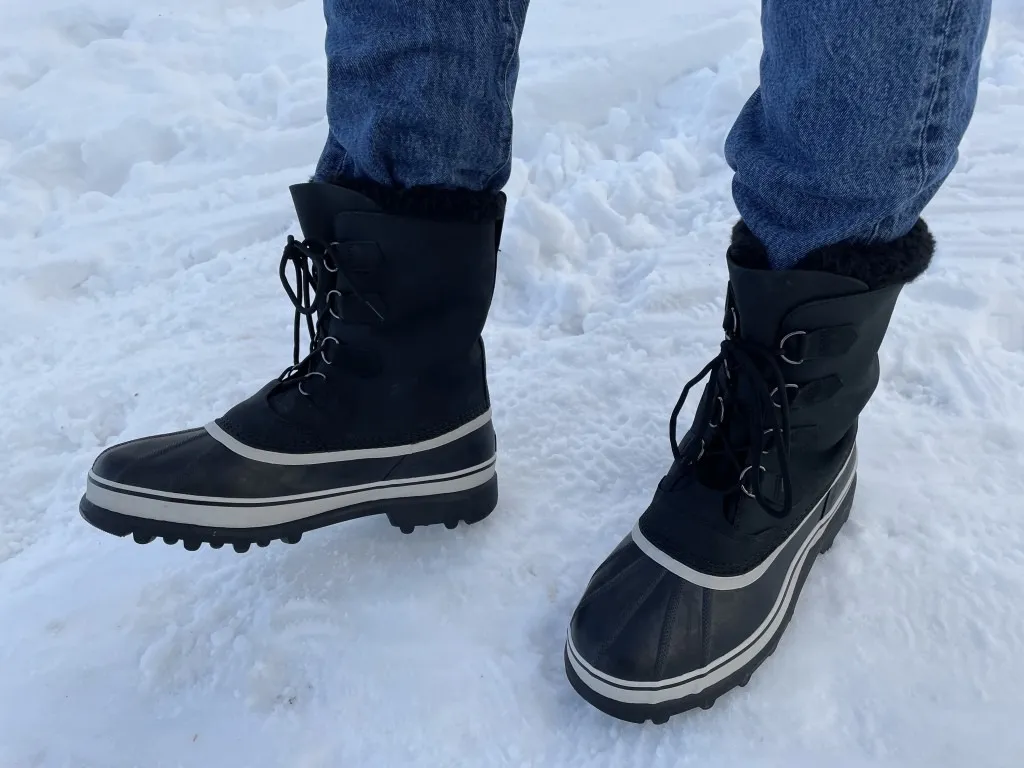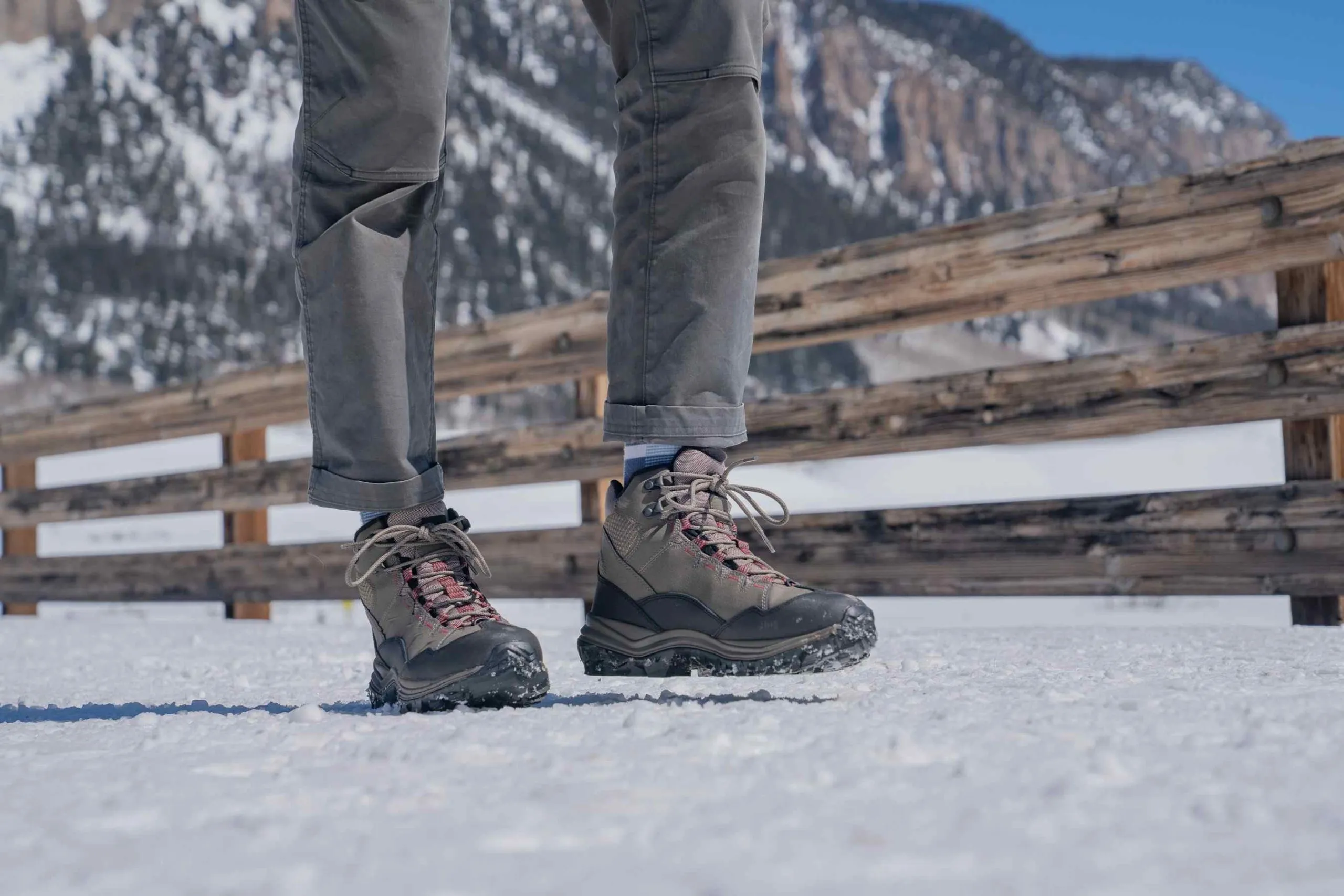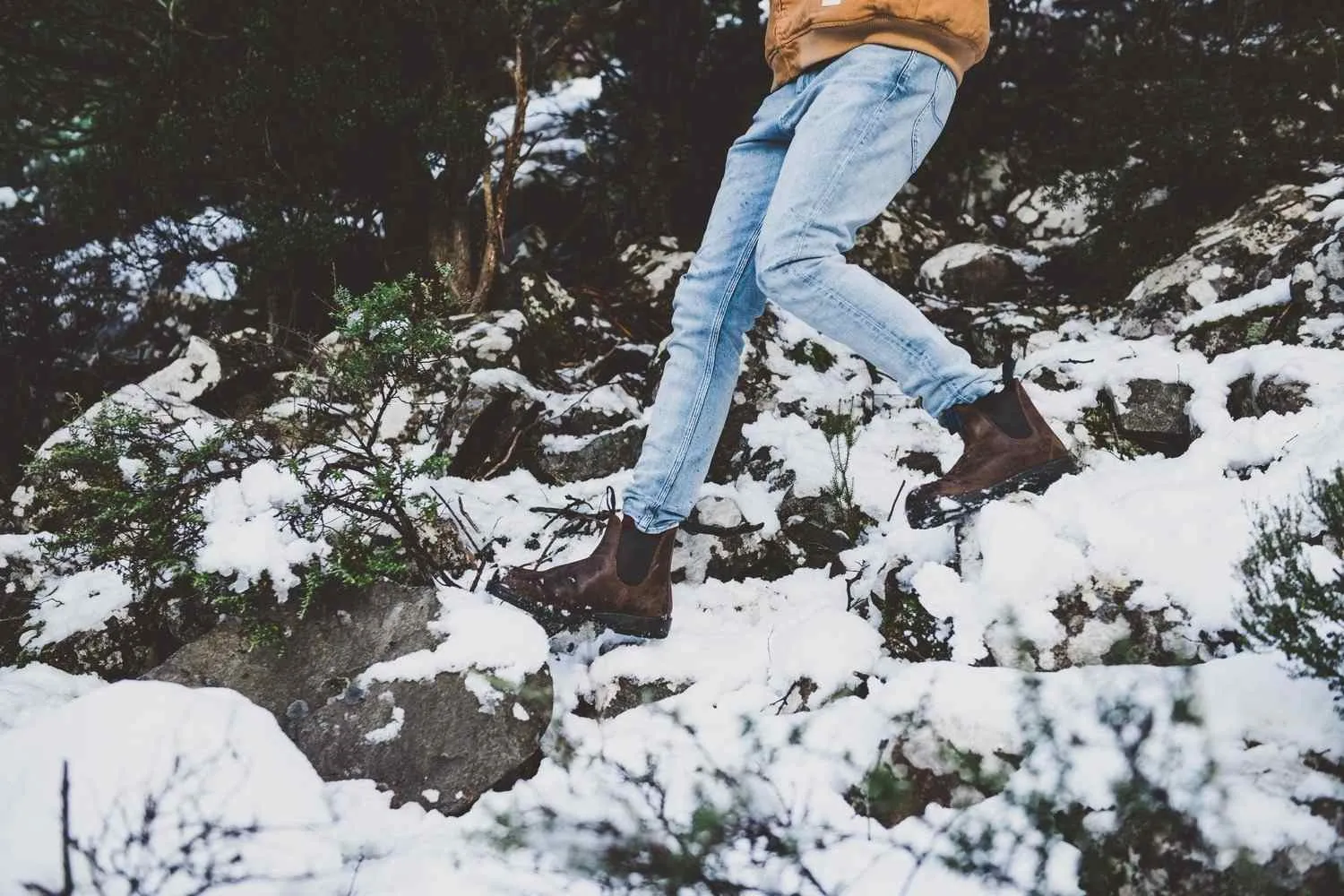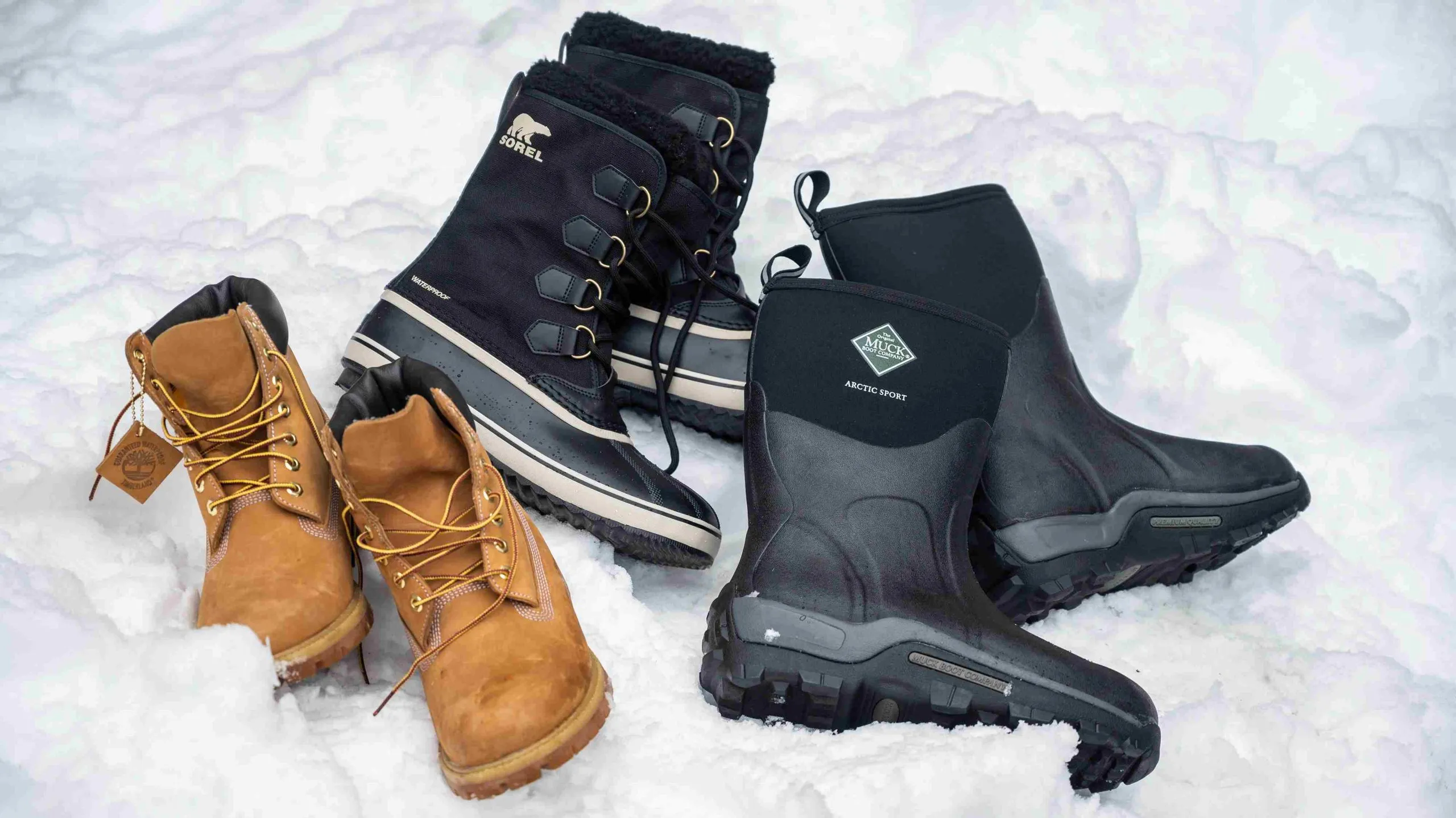When winter arrives with its icy sidewalks and deep snowdrifts, having the right footwear can make all the difference. Whether you’re heading out for a snowy hike, commuting through slushy streets, or simply enjoying a winter getaway, choosing the best snow boots is essential for staying warm, dry, and comfortable. But with so many styles, materials, and features to consider, finding the perfect pair can feel overwhelming.
In this guide, we’ll explain how to choose the best snow boots based on insulation, waterproofing, traction, and fit. We’ll help you find the right pair for your winter adventures. Ready to step into the season with confidence? Let’s get started with the National Park Shops!
Why wear snow boots in winter?
Snow boots are an essential choice for winter footwear, designed specifically to handle cold, wet, and slippery conditions. However, knowing how to choose the best snow boots can make all the difference in ensuring maximum comfort and protection. Their insulation keeps feet warm by trapping heat, preventing frostbite when temperatures drop below freezing. Unlike regular shoes that allow the cold to seep in, snow boots provide necessary protection against harsh winter elements. In addition to warmth, they are waterproof to keep feet dry in snow, slush, or rain, preventing discomfort and reducing the risk of hypothermia in extreme conditions.
Traction is another key advantage, as icy sidewalks and snowy paths can be hazardous. Snow boots feature grippy outsoles with deep lugs or specialized rubber that help prevent slips and falls – something regular shoes lack. Understanding how to choose the best snow boots means looking for features like slip-resistant soles and proper ankle support. Moreover, their high cuffs and snug fit prevent snow from sneaking into your footwear, unlike low-top sneakers or ankle boots that expose your feet. Built for comfort, snow boots also provide cushioning and support for walking on uneven, snowy terrain, ensuring feet remain comfortable even in the harshest conditions.

Durability is another factor that sets snow boots apart. They are made with rugged materials to withstand the challenges of winter, including exposure to salt, ice, and repeated wet-dry cycles, while everyday shoes may deteriorate quickly under such stress. How to choose the best snow boots also depends on selecting high-quality materials that can endure winter’s toughest conditions. When compared to alternatives, snow boots prove to be superior. Sneakers lack insulation, grip, and water resistance, making them unsuitable for winter. Fashion boots may look stylish but often fail to provide adequate warmth or waterproofing. Even hiking boots, while more durable, are not always insulated enough for deep colds or designed for the unique demands of snowy environments.
Ultimately, snow boots are the best choice for winter conditions, offering warmth, dryness, and safety in ways that other footwear cannot. Learning how to choose the best snow boots ensures that you get the perfect pair for your needs. If you expect to face snow, ice, or freezing temperatures, they are not just a luxury but a necessity.
Types of Snow Boots
Each type of boot serves a different purpose, with some being better suited for certain conditions than others. We’ve classified them into three main categories: All-Around Use, Pac Boots, and Active Hiking Boots.
All-Around Use Boots
All-Around Use Boots are designed for light hiking, commuting in cold weather, and all-day wear. Whether you’re heading to work, strolling through town, enjoying après-ski moments, or dining out with friends, they provide a perfect balance of function and style.
This is likely the largest category of winter boots available, with most models offering adaptability across different conditions. Compared to Pac Boots and Active Hiking Boots, these options tend to be more stylish and breathable, making them comfortable for all-day wear, even with casual outfits like jeans. If you’re wondering how to choose the best snow boots for both practicality and fashion, this category is an excellent starting point.

>> Related articles that you may be interested in: The 7 Best Mountaineering Boots for Travelers
Pac Boots
When exploring how to choose the best snow boots, Pac boots stand out as the top choice for extreme cold and heavy snowfall, primarily suited for around-town wear and winter chores. These boots are defined by their thick rubber shell surrounding the foot, paired with a waterproof or water-resistant upper and a removable insulating liner. This combination provides excellent weather resistance, making Pac boots highly durable with tall shafts, thick soles, and outstanding insulation. They perform best in deep snow where traction on steep or icy terrain is less of a concern, as their flat outsoles are designed to enhance floatation over snow rather than grip icy surfaces.
However, there are trade-offs when considering how to choose the best snow boots in this category. Fit tends to be roomy rather than snug, often lacking dedicated arch support. The lacing system is simplistic, allowing for quick pull-on and removal but offering less precision in fit adjustment. Additionally, traction is minimal, with flat, wavy patterns instead of deep lugs, which makes them less effective on icy ground. Attaching microspikes to these boots can also be challenging due to their sole design.

Active Winter Hiking Boots
When considering how to choose the best snow boots, an active hiking boot is an ideal choice for those who love winter hiking and outdoor adventures. Designed for movement in snowy and rugged terrain, these boots feature a snug lacing system and a rigid upper, ensuring a precise fit and enhanced stability on technical trails. Their structured design allows hikers to kick steps into steep snow-covered slopes with ease and makes them compatible with snowshoes or microspikes for added grip in icy conditions.
A key advantage of active hiking boots is their breathability. Built for high-intensity activity, they incorporate breathable textiles that help keep feet warm and dry throughout the day. Traction is another standout feature, with deep, long rubber lugs that provide a secure grip on steep, snowy surfaces, reducing the risk of slipping.
However, when deciding how to choose the best snow boots, there are a few trade-offs to consider with this type. These boots tend to have a more technical appearance and take longer to put on and remove compared to other winter footwear. Their shorter shaft height enhances mobility but may require the addition of gaiters to prevent snow from entering the cuff. Additionally, due to their streamlined construction, they don’t offer as much flotation in deep snow.

>> Related articles that you may be interested in: 7 Best Snow Chains For Boots: For Men & Women (Tested)
How to choose the best Snow Boots?
Sizing and Fit
When determining how to choose the best snow boots, getting the right size is crucial to ensuring warmth, comfort, and proper circulation during winter. It’s important to compare your foot size to the manufacturer’s sizing chart and read reviews to determine if a particular boot runs true to size, smaller, or larger.
To maximize warmth and comfort, your feet should be well-supported, and your toes should have enough room to move without feeling cramped. This balance is key when evaluating how to choose the best snow boots, as the right fit directly impacts both warmth and overall performance in winter conditions.
Traction (Outsole Grip)
When choosing the best snow boots, traction is a critical factor due to the potential hazards of icy and snowy conditions. A boot’s outsole grip directly influences safety by reducing the risk of slips and falls, which can lead to serious injuries. High-traction boots are designed with specialized rubber compounds and tread patterns that enhance grip on slippery surfaces, adapting to various terrains, including ice and packed snow. Therefore, prioritizing traction in snow boots ensures not only comfort but also safety during winter activities.
Insulation and Warmth
When considering how to choose the best snow boots, two key performance factors to evaluate are water resistance and warmth, both of which are heavily influenced by the boot’s construction. The level of warmth a boot provides depends on the quality of its insulation, the thickness of the outsole, and the design of the footbed.
Through testing, we’ve observed that boots with a slightly roomier toe box tend to warm up more quickly than those with a narrow or restrictive fit. This is an important detail to consider when selecting how to choose the best snow boots, as proper fit and insulation work together to ensure maximum comfort and warmth in cold conditions.

Water Resistance
Winter boots achieve water resistance or waterproofing through various methods, such as using treated leather, nylon, or rubber, or by incorporating a waterproof and breathable membrane between the insulation and the outer shell. Pac and snow boots typically utilize the first method, while winter hiking boots generally employ the second, making them particularly effective for active pursuits. Both techniques can result in completely waterproof footwear, provided they are constructed with quality materials.
In addition, most winter boots are treated with a Durable water-repellent (DWR) finish that prevents water from soaking into the outer material, causing it to bead on the surface. To maintain their water resistance over time, materials like leather, suede, and nylon may require re-treatment, whereas rubber tends to remain water-resistant throughout the life of the boot.
>> Read More: 8 Best Waterproof Hiking Pants on Amazon
Lacing
Lacing and unlacing winter boots can often be a frustrating task that stands between you and your outdoor adventures or cozy moments by the fire. The ease with which you can put on and take off your boots, as well as how quickly you can achieve the right snugness and support, is crucial, especially if you need to remove them frequently. Pac boots are designed with a looser fit, making them simpler to slip in and out of, requiring less precise lacing since they don’t need to be tightened as much.
In contrast, winter hiking boots typically take more time to secure; some models allow for a single, smooth pull from the top, while others necessitate tightening each lace individually from the toes upward. Alternatively, there are several slip-on winter boots available that eliminate this hassle. This simplicity is appreciated, as these boots often provide a comfortable fit for all-day wear. When considering how to choose the best snow boots, it’s essential to factor in these aspects for convenience and comfort.
Weight and Comfort
Comfort is a crucial factor to consider when selecting your boots, particularly if you intend to hike or walk long distances. The weight of the boots is another important consideration; while heavier boots can be suitable for standing outside in cold conditions for warmth, they can become burdensome if worn for extended periods while on the move. To assist you in making an informed choice on how to choose the best snow boots, we weigh each boot we test to highlight this aspect and help distinguish between different models.
Tall vs Short Boots
We define a tall boot as one that measures 10 inches or more, while a short boot is anything under that height. Both styles have their advantages and disadvantages. The primary benefit of taller boots is their ability to provide enhanced protection against deep snow and extra warmth for your calves. However, they tend to be less agile and offer reduced mobility compared to short boots, which are typically designed for use on plowed sidewalks and trails.
In our review, most pairs of short boots were suitable for hiking. While they may not offer as much protection from snow, many still provide significant water resistance against puddles and slush. For those living in areas where snowfall is minimal, short boots can adequately meet your winter needs. If you choose to go with a shorter boot but need to navigate deeper snow, opt for one with a cinching shaft or a mechanism to attach a gaiter for added protection.

Style and Purpose
When selecting how to choose the best snow boots, it’s crucial to consider both style and purpose, as these elements significantly influence functionality and personal expression. Snow boots are specifically designed for various activities, such as hiking, trudging through deep snow, or casual outings, which determine the necessary levels of insulation, waterproofing, and traction.
For example, boots designed for rugged outdoor activities will emphasize durability and performance over aesthetics, while a more fashionable option might prioritize appearance, potentially sacrificing some functionality. Furthermore, choosing boots that match your personal style ensures you feel confident and comfortable while navigating winter conditions. Therefore, recognizing the balance between style and purpose is essential for making an informed decision that fulfills both practical requirements and fashion preferences.
Budget
When choosing the best snow boots, considering your budget helps you find a balance between quality and affordability. Snow boots can vary significantly in price, often reflecting the materials, technology, and brand reputation. Setting a budget allows you to narrow down options that meet your performance needs without overspending. It’s important to remember that investing in a higher-quality pair may provide better insulation, waterproofing, and durability, ultimately saving money in the long run by reducing the need for replacements.
Best Snow Boots on Amazon (According to National Park Shops)
- Best Overall: The North Face Chilkat V 400 ($159 on Amazon)
- Best Value: Oboz Bangtail ($131.08 – $225.64 on Amazon)
- Best for Men: The Original Muck Boot Company Arctic Sport ($123.47 on Amazon)
- Best for Women: Baffin Chloe ($177.71 – $185.00 on Amazon)
- Best for Extreme Cold: Baffin Impact ($239.20 – $260 on Amazon)
Conclusion
Knowing how to choose the best snow boots is key to enjoying your winter adventures without discomfort or concern. By considering essential factors, you can find the perfect pair that meets your specific needs. Remember, the right snow boots not only keep your feet warm and dry but also provide the support and stability necessary for navigating icy terrains.


